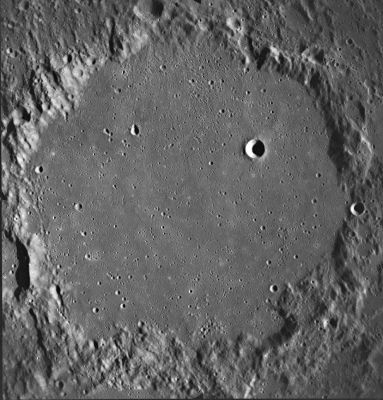Ptolemaeus
Contents
Ptolemaeus (and Ammonius on its floor)
|
Lat: 9.12°S, Long: 1.85°W, Diam: 158.3 km, Depth: 2.4 km, Rükl: 44, pre-Nectarian |

Apollo AS16-M-1673 from Stefan Lammel
The largest one of the bowl shaped craterlets on the floor of Ptolemaeus is officially known as Ammonius
Images
LPOD Photo Gallery Lunar Orbiter Images Apollo Images ASU Apollo Image Archive (WARNING: the first two frames in the LPI's list of orbital Apollo photographs of Ptolemaeus are totally wrong, because both Apollo 10 photographs show the moon's farside; the region east of Joliot and Lomonosov)(error detected by - DannyCaes Nov 17, 2012).
- A rather strange look at Ptolemaeus's floor is seen in one of the oblong orbital photographs made during the mission of Luna 22. In this photograph, Ptolemaeus was captured at the central part of the oblong frame (scroll to the right, to the frame's centre).- DannyCaes Aug 8, 2010
Maps
(LAC zone 77D2) LAC map Geologic map LM map LTO map
Description
Elger
(IAU Directions) PTOLEMAEUS.--Taking its very favourable position into account, this is undoubtedly the most perfect example of a walled-plain on the moon's visible superficies. It is the largest and most northerly component of the fine linear chain of great enclosures, which extend southwards, in a nearly unbroken line, to Walther. It exhibits a very marked departure from circularity, the outline of the border approximating in form to a hexagon with nearly straight sides. It includes an area of about 9,000 square miles, the greatest distance from side to side being about 115 miles. It is, in fact, about equal in size to the counties of York, Lancashire, and Eastmorland combined; and were it possible for one to stand near the centre of its vast floor, he might easily suppose that he was stationed on a boundless plain; for, except towards the east, not a peak, or other indication of the existence of the massive rampart would be discernible; and even in this direction he would only see the upper portion of a great mountain on the wall.
The border is much broken by gaps and intersected by passes, especially W. and S., where there are several valleys connecting the interior with that of Alphonsus. The loftiest portion of the wall, which includes many crateriform depressions, is on the E., where one peak rises to nearly 9,000 feet. Another on the N.W. is about 6,000 feet above the interior. On the N.E. is a remarkable crater-row, called, from its discoverer, "Webb's furrow," running from a point a little N. of a depression on the border to a larger crateriform depression on the S. of Hipparchus K. Birt terms it "a very fugitive and delicate lunar feature." As regards the vast superficies enclosed by this irregular border, it is chiefly remarkable for the number of large saucer-shaped hollows which are revealed on its surface under a low sun. They are mostly found on the western quarter of the floor. Some of them appear to have very slight rims, and in two or three instances small craters may be detected within them. Owing to their shallowness, they are very evanescent, and can only be glimpsed for an hour or so about sunrise or sunset. The large bright crater A, about 4 miles in diameter on the N.E. side of the interior, is by far the most conspicuous object upon it. Adjoining it on the N. is a large ring with a low border, and N. of this again is another, extending to the wall. Mr. Maw and Mr. Mee have seen minute craters on the borders of these obscure formations. In addition to the objects just specified, there is a fairly conspicuous crater, d, on the N.W. quarter of the floor, and a very large number of others distributed on its surface, which is also traversed by a network of light streaks, that have recently been carefully recorded by Mr. A.S. Williams. A cleft, from near Reaumur A, traverses the N. side of the floor, and runs up to Ptolemaeus d.
Wikipedia
Additional Information
- IAU page: Ptolemaeus
- Depth data from Kurt Fisher database
- Westfall, 2000: 2.4 km
- Cherrington, 1969: 2.98 km
- Ptolemaeus A is a thermal anomaly crater, implying a youthful age - Moore et al, 1980
- According to Both (1971), the saucers on the floor of Ptolemaeus were discovered by Kunowsky.
- A curious field of small domes is noticeable near the southern part of Ptolemaeus's rim (on its floor), which is an interesting target for dedicated observers (with not-too-small telescopes). Discovered by Danny Caes on orbital B&W Hasselblad photographs made during the mission of Apollo 16. See frames AS16-124-19839, 19840, 19841, 19842, 19843, and 19844.
Nomenclature
- Named for Claudius Ptolemy (c. 87-150), a Greek astronomer, mathematician, geographer.
LPOD Articles
A Long Line in a Clutter of Magnificence.
Micro-Topo
Cups & Saucers
Ptolemy's Strange Floor
The Golden Triad
Ptolemaeus Peak Heights
Ptolemaic Sunset
Unfamiliar Territory
Ramparts (wonderful sunrise shadows on the floor of Ptolemaeus!)
Nessie (peculiar clair-obscur effect, discovered by Joe Adlhoch, Colorado)
Bibliography
- Apollo Over the Moon -- A View from Orbit
- Chapter 3: The Terrae (Part 2), Figures 54 and 55.
- Chapter 5: Craters (Part 3), Figures 128, 129, 132, 133 (several regions in and near Ptolemaeus, and also near Albategnius).
- MacRobert, Alan. 1991. Sunrise on Ptolemaeus. Sky and Telescope vol. 81, no. 6 (June issue), pp. 631-633. includes photo by Strathmore R. B. Cooke, taken 1965 April 9, 3:19 UT, showing early streaks of sunlight on floor
- Wood, C.A. Jun. 2002. Exploring Ptolemaeus. Sky and Telescope June 2002 (vol. 103) p. 106.
Named Features -- Prev: Protagoras -- Next: Puiseux